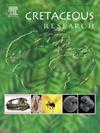来自Villa de Leiva (boyac,哥伦比亚)Aptian的一种大型板状鲨鱼,基于第一个保存牙齿和椎骨的下白垩纪鲨鱼标本
IF 1.7
3区 地球科学
Q1 GEOLOGY
引用次数: 0
摘要
我们描述了来自Villa de Leiva(哥伦比亚)Paja组的Arcillolitas abigarradas上Aptian的一种新的板形鲨鱼标本。它代表了下白垩纪第一个保存了牙齿和椎骨的板状鲨鱼标本。标本由几颗脱臼但保存完好的牙齿和保存完好的部分脱臼的椎体中心、牙髓和软组织组成。我们认为该标本属于richaurtei原olamna,这是最近从同一地层中发现的标本中生长出来的一个物种。它是一种板形鲨鱼,其特征是成比例的小撕裂型牙齿,具有小三角形的主尖,两对小三角形的侧尖,和巨大的双叶根。该标本代表了一个成熟的个体,总长度为6.65米,使其成为最古老的巨型板形动物记录。该标本首次证明,并非所有巨噬细胞板状体都遵循冠高与体长的线性关系。我们的埋藏学分析表明,标本必须迅速到达缺氧的底部,底栖生物活动低,水流温和,微生物席促进了软组织的快速磷化。根据保存下来的解剖结构,我们认为ricaurteprotoolamna是一种相对缓慢但活跃的游泳者,以热带近岸地区的小型猎物为食,如硬骨鱼、小鲨鱼、鱿鱼和甲壳类动物。本文章由计算机程序翻译,如有差异,请以英文原文为准。
A large lamniform shark from the Aptian of Villa de Leiva (Boyacá, Colombia), based on the first Lower Cretaceous shark specimen preserving both teeth and vertebrae
We describe a new specimen of a lamniform shark from the upper Aptian of the Arcillolitas abigarradas Member of the Paja Formation of Villa de Leiva (Colombia). It represents the first lamniform shark specimen from the Lower Cretaceous with both teeth and vertebrae preserved. The specimen consists of several disarticulated but well-preserved teeth and well-preserved partially articulated vertebral centra, denticles and soft tissues. We refer the specimen to Protolamna ricaurtei, a species recently erected from a specimen found in the same formation. It is a lamniform shark characterized by proportionally small tearing-type teeth with small triangular main cusp, two pairs of small triangular lateral cusplets, and massive bilobated roots. The specimen represents a mature individual to be 6.65 m in total length, making it the oldest record of a gigantic lamniform. This specimen is the first evidence that not all macrophagous lamniforms follow the linear function relating crown height to total body length. Our taphonomic analysis indicates that the specimen must have rapidly reached an anoxic bottom, with low benthic activity, gentle currents, and with microbial mats that facilitated the rapid phosphatization of the soft tissues. Based on the preserved anatomy, we propose that Protolamna ricaurtei was a relatively slow but active swimmer feeding in tropical near-shore areas over small preys such as bony fishes, small sharks, squids, and crustaceans.
求助全文
通过发布文献求助,成功后即可免费获取论文全文。
去求助
来源期刊

Cretaceous Research
地学-地质学
CiteScore
4.10
自引率
19.00%
发文量
235
审稿时长
12 weeks
期刊介绍:
Cretaceous Research provides a forum for the rapid publication of research on all aspects of the Cretaceous Period, including its boundaries with the Jurassic and Palaeogene. Authoritative papers reporting detailed investigations of Cretaceous stratigraphy and palaeontology, studies of regional geology, and reviews of recently published books are complemented by short communications of significant new findings.
Papers submitted to Cretaceous Research should place the research in a broad context, with emphasis placed towards our better understanding of the Cretaceous, that are therefore of interest to the diverse, international readership of the journal. Full length papers that focus solely on a local theme or area will not be accepted for publication; authors of short communications are encouraged to discuss how their findings are of relevance to the Cretaceous on a broad scale.
Research Areas include:
• Regional geology
• Stratigraphy and palaeontology
• Palaeobiology
• Palaeobiogeography
• Palaeoceanography
• Palaeoclimatology
• Evolutionary Palaeoecology
• Geochronology
• Global events.
 求助内容:
求助内容: 应助结果提醒方式:
应助结果提醒方式:


